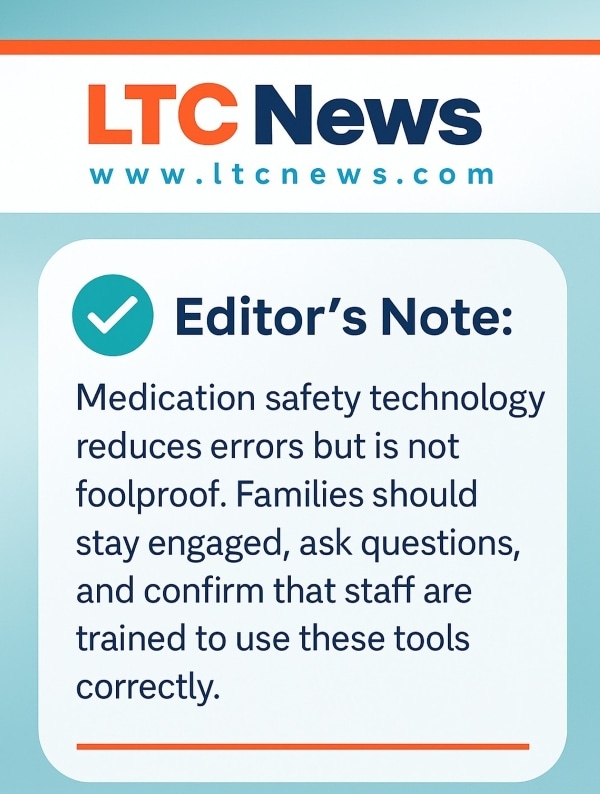Smarter, Safer Extended Care: How Technology Protects Your Loved One from Medication Errors

If your parent or other loved one lives in assisted living, a nursing home, or even at home with caregivers, you’ve probably asked yourself a troubling question: Are their medications being given safely?
For families, this worry is constant. A missed dose, a wrong pill, or a simple miscommunication can lead to sudden hospital trips, lasting health problems, or worse.
Medication mistakes are far more common than most people realize, and for older adults—often managing multiple prescriptions—the stakes are even higher. Families want to trust that every pill, infusion, and schedule is handled with care. Yet overworked staff, complex drug regimens, and outdated systems leave too much room for error.
The encouraging news is that technology is stepping in to protect your loved ones. From barcode scanning in nursing homes to smart pill dispensers at home, these tools are helping families feel more confident that medications are managed safely.
Where Mistakes Happen
Errors often begin at the prescription stage. The World Health Organization estimates that up to 53 percent of medication errors occur when a doctor orders a drug. Doses may be miscalculated, allergies overlooked, or prescriptions not adjusted for an older adult’s frailty.
When medications are given, mistakes can also include:
- Wrong dose (27% of errors)
- Wrong drug (18%)
- Wrong method of delivery (15%)
Poor documentation makes the risks worse. Families often aren’t told when doses are late or skipped, and paper-based records can be unclear when staff change shifts. For older adults on multiple prescriptions—such as blood thinners, insulin, or antibiotics—the consequences can be life-threatening.
Tech That’s Changing the Equation
Extended care facilities and in-home caregivers are increasingly turning to smart systems that prevent errors before they happen.
Automated Dispensing Cabinets (ADCs)
These computer-controlled cabinets securely store medications and track every dose removed. When linked to electronic health records, pharmacists can verify prescriptions before they reach your loved one. For families, this means fewer opportunities for a mix-up behind the scenes.
Smart Infusion Pumps
For older adults needing IV medications, infusion pumps with dose error reduction software set upper and lower safety limits. They prevent overdosing or underdosing by alerting staff before harm occurs. One large-scale project showed compliance rates jumped from 46 to 78 percent when these pumps were used.
Barcode and RFID Scanning
By scanning both a patient’s wristband and the medication vial, staff confirm the “five rights”: right patient, right drug, right dose, right route, and right time. After adopting barcode scanning, Concord Hospital in New Hampshire reported an 80 percent reduction in medication errors. For families, this is a reassurance that someone is double-checking every time.
Electronic Batch Records in Pharma
Behind the scenes, manufacturers now use electronic records to ensure every batch of medication is consistent and traceable. Electronic batch record processes have transformed pharmaceutical manufacturing, and modern EBR software takes this a step further by replacing paper records with self-auditing digital systems that reduce errors.
Families may not see this technology, but it improves trust that the pills or vials dispensed are safe from the start.
Medication Monitoring and Real-Time Safety
Where technology truly shines is in continuous monitoring, giving families and staff early warnings when something is off.
- Real-time alerts notify caregivers if a dose is missed or given incorrectly.
- EHR integration ensures all providers—doctors, pharmacists, and nurses—see the same medication history.
- Analytics tools help spot dangerous drug combinations or unnecessary prescriptions.
Medication monitoring gives us eyes on patients 24/7. Instead of reacting to mistakes, we’re preventing them before they happen. — Dr. Jennifer Schiller, a geriatric pharmacist at the University of Minnesota.
For families, this means fewer surprises and more confidence that care teams are staying on top of complex medication schedules.
For Family Caregivers at Home
Medication management challenges don’t stop at the nursing home door. If you’re helping a parent age in place, you know how overwhelming multiple pill bottles and confusing schedules can be.
New consumer technology is bridging the gap:
- Smart pill dispensers that lock until the right time, preventing double-dosing.
- Medication reminder apps that text or buzz both you and your loved one.
- Remote monitoring platforms that alert you when a dose is missed.
These tools provide peace of mind for adult children balancing work, caregiving, and their own families. For those supporting parents with dementia, these tools reduce the risk of dangerous lapses and help avoid costly hospital stays.
Why Some Facilities Still Lag
Despite proven benefits, many nursing homes and assisted living facilities have been slow to adopt advanced systems. Common barriers include:
- High upfront costs on tight budgets
- Staff resistance to new workflows
- Integration problems across outdated IT systems
- Limited training that reduces effectiveness
- Ongoing maintenance needs for hardware and software
As a family, you should ask facilities how they manage medications. Do they use barcode scanning? Are infusion pumps monitored? Are records digital or paper-based? These questions can help you identify providers who prioritize safety.
Long-Term Care Insurance can also make a difference. A loved one with LTC Insurance coverage often has access to higher-quality facilities that use advanced medication systems.
If you are looking for quality long-term care services for a loved one, use the tools available on LTC News.
- Guide to Home Care: Services, Costs, and Search Tools
- Guide to Assisted Living: Facility Services, Costs, and Search Tools
- Complete Guide To Nursing Homes
The Future of Medication Safety
Medication management has moved beyond paper charts and pill boxes. With tools like barcode scanning, automated cabinets, and real-time monitoring, facilities and families can prevent errors that once seemed inevitable.

Technology won’t replace human oversight—but it gives caregivers the safety net they need. For families, that means greater confidence when you’re not there to watch every dose.
The next time you tour an assisted living facility or refill a weekly pill organizer at home, ask: Is technology protecting the person I love from medication errors?


